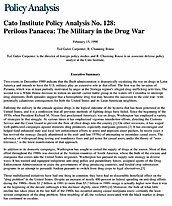Enlisting the military in the crusade against drugs is the logical outcome of the hysteria that has been generated in the United States, and it is a confession that all previous methods of fighting drugs have failed. Since the beginning of the 1970s when President Richard M. Nixon first proclaimed America’s war on drugs, Washington has employed a variety of strategies in that struggle. At various times it has emphasized vigorous interdiction efforts, directing the Customs Service and the Coast Guard to prevent the flow of illicit drugs into the country.[1] On other occasions, it has waged well-publicized campaigns against domestic drug producers, especially marijuana growers.[2] It has encouraged and helped fund enhanced state and local law enforcement efforts to arrest and imprison street pushers. In recent years it has revived the strategy (largely abandoned in the mid- and late 1970s) of attempting to intimidate casual users. The advocacy of widespread drug testing and mandatory fines and jail terms for casual users, under the theory of “zero tolerance,” is the latest manifestation of that approach.
In addition to its domestic campaigns, Washington has sought to curtail the supply of drugs at the source. Most of that effort throughout the 1980s was directed at the Andean countries of South America, where the bulk of the cocaine and marijuana that comes into the United States originates. Washington has pursued its supply-side strategy in diverse ways. It has trained and equipped indigenous anti-drug police and paramilitary forces, assigned agents of the Drug Enforcement Administration to assist the governments of drug-producing countries, and funded crop substitution programs in an attempt to persuade Andean peasants to switch from drug crops to legal alternatives.[3]
Those multifaceted initiatives have had one thing in common: they have had no discernible beneficial effect on the “drug problem” in the United States. Despite an increase of nearly 400 percent in federal spending on anti-drug efforts during the 1980s–from $1.2 billion in 1981 to more than $5.7 billion in 1989–usage is actually higher now than it was at the beginning of the decade (although it has declined slightly since 1985).[4] Moreover, the bulk of what little decline has taken place in the last half of the 1980s has occurred among casual marijuana users–certainly the least serious component of the drug problem. Most troubling of all, the violence associated with the black market in drugs has continued to escalate.
As proponents of the war on drugs have seen all of their strategies fail, they have begun to exhibit intense frustration. That frustration is translated into a desperate search for “tougher” measures that will, somehow, achieve the victory that has thus far Proven so elusive.

